
The Lonely Planet guide to Glasgow Cathedral and Necropolis, Scotland


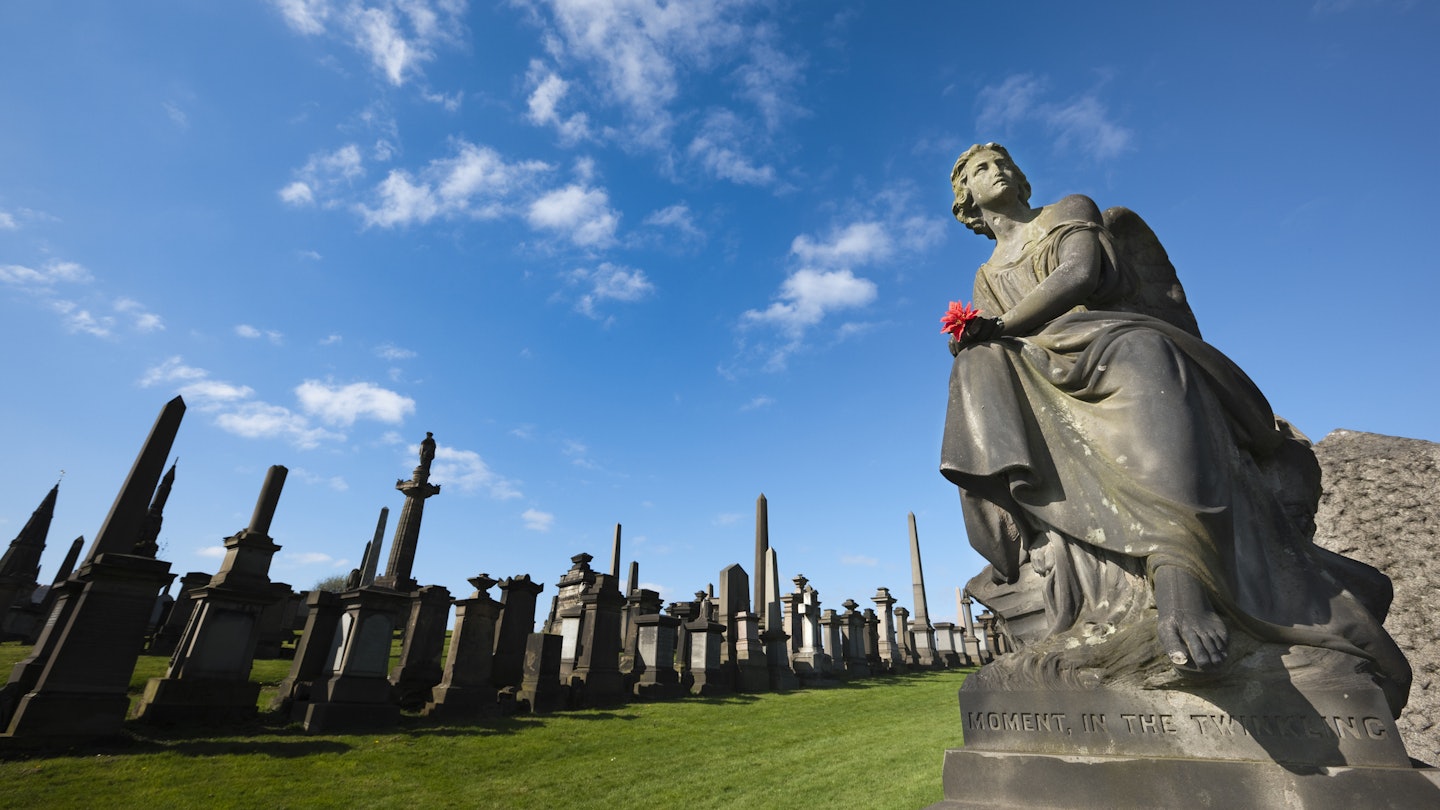
The Glasgow Necropolis contains many of the city's grandest tombs. theasis/Getty Images
A great way to understand a city is to visit the places where its people worship, and the final resting places of its movers and shakers. Just as no visit to Paris would be complete without a trip to Notre-Dame and Père Lachaise Cemetery, no trip to Glasgow would be complete without a turn around Glasgow Cathedral and the historic Glasgow Necropolis.
Scotland’s largest city by population, Glasgow is known as much for its humor and attitude as for its buildings – but there’s grand architecture to rival anything in Edinburgh if you know where to look. The city’s towering 13th-century cathedral is one of the finest examples, and one of only two medieval cathedrals in Scotland to make it through the Reformation in one piece.
Behind the cathedral, the vast 19th-century Glasgow Necropolis stretches picturesquely up and over a green hillside, with around 3500 gravestones of the city’s great and good, and ambitious and lucky...and everything in between.
Wandering between the elaborate tombs of the city’s wealthy industrialists is an intriguing journey through history, offering great views over the city and a tantalizing Gothic thrill. Both the cathedral and the cemetery should definitely be on your list of the best things to do in Glasgow.
Discover more with our guide to getting the best from a visit to Glasgow Cathedral and the Glasgow Necropolis.
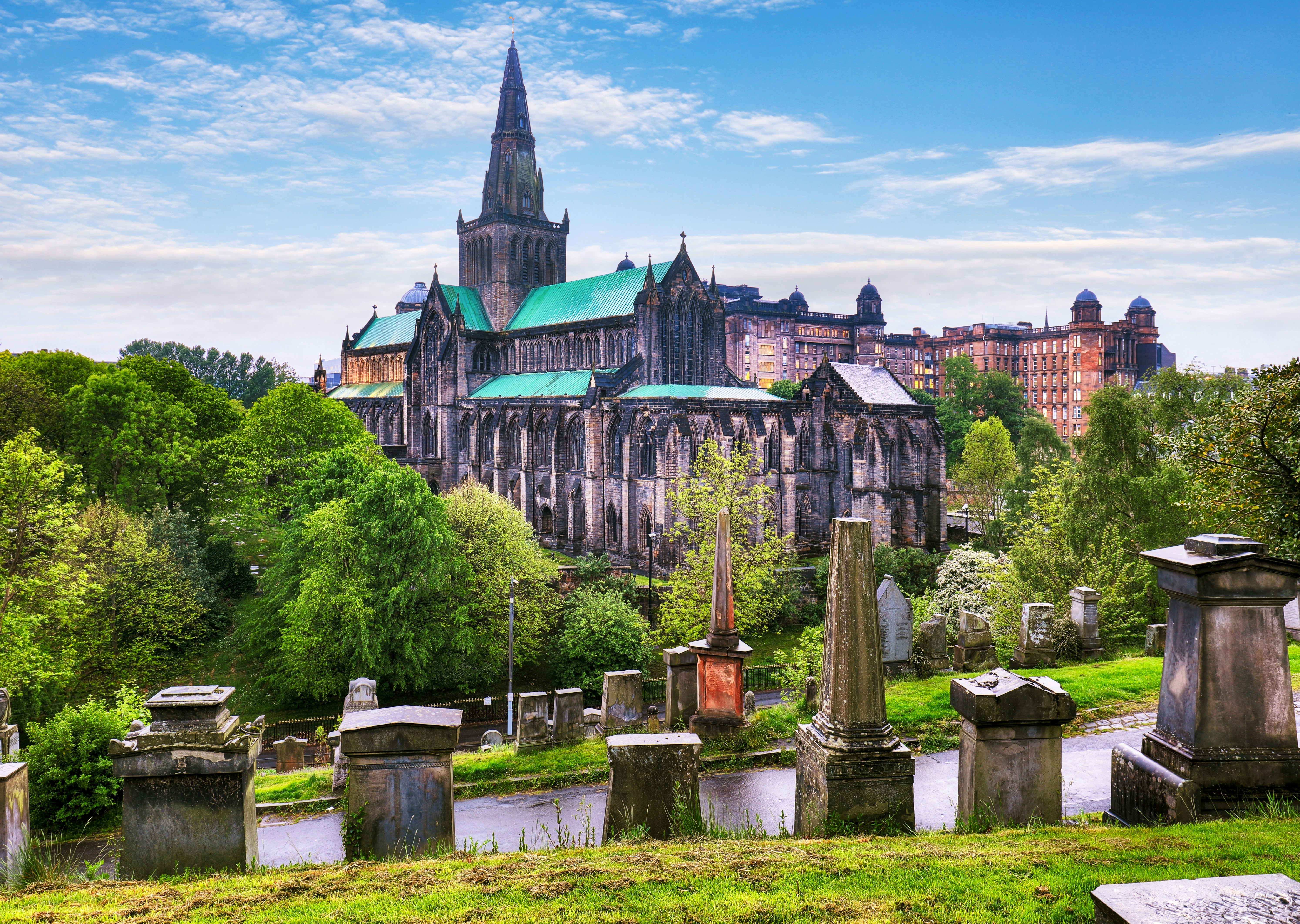
What’s the history of Glasgow Cathedral and the Glasgow Necropolis?
Glasgow Cathedral has a timeless quality; the dark, imposing interior conjures up medieval might and sends a shiver down your spine. It’s a shining example of European Gothic architecture and, unlike nearly all of Scotland’s other cathedrals, it survived the anti-Catholic purges of the Reformation almost intact.
Built over the revered tomb of St Mungo between 1250 and 1500 and replacing an even older wooden cathedral that occupied the site from 1136, Glasgow Cathedral was the kernel around which the medieval city formed. Unlike other religious buildings in Scotland, it came through the Protestant Reformation of 1560 (when many Catholic churches were defaced or destroyed) with little damage.
As the oldest surviving building in Glasgow, the cathedral offers a rare glimpse of the city’s medieval life, as almost everything else from the period was lost as Glasgow expanded into an industrial powerhouse and port city for the British Empire, or destroyed during the Blitz in WWII. The cathedral has seen many renovations and modifications during its long existence, including the installation of modernist stained glass windows by Francis Spear in the 1950s.
Once a Georgian pleasure garden known as Fir Park, the hill behind the cathedral was converted into a cemetery in the 1830s and rapidly became popular with the city’s upper classes. In a city marked by religious tensions, the Glasgow Necropolis was notable for being interdenominational – indeed, the very first person buried here was a Jewish jeweler called Joseph Levi in 1832.
Today, the graveyard is only used for burials by families who have existing tombs on the site. Still, more than 50,000 Glasgow residents are interred here, with 3500 grand funerary monuments, including tombs designed by Alexander Thomson and Charles Rennie Mackintosh.
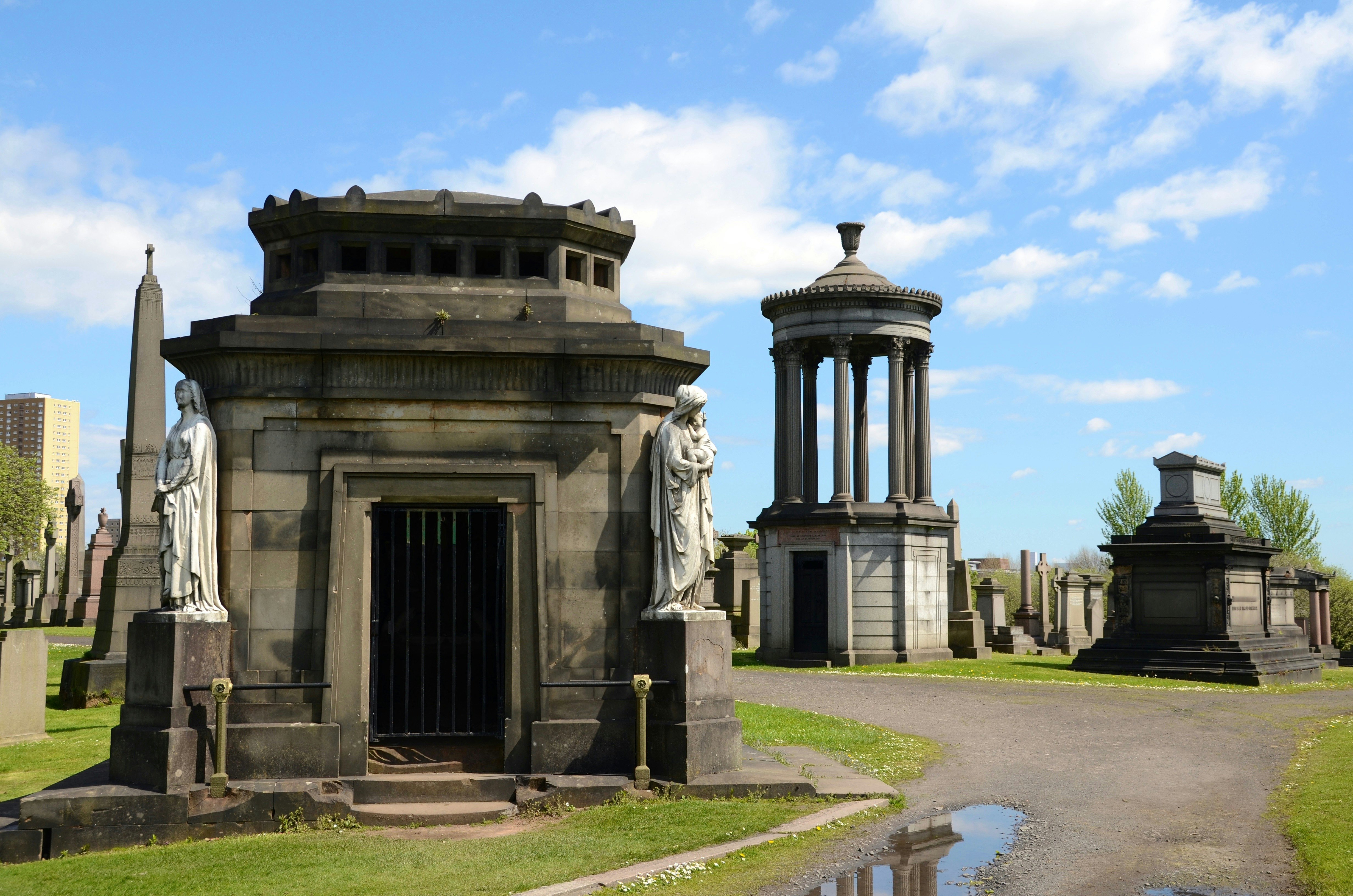
When should I visit Glasgow Cathedral and the Necropolis?
Summer is the best time to visit Glasgow’s grand cathedral and cemetery. The weather is warm but rarely too hot, and days are more likely to be dry than in the cooler, damper spring and fall, or the gloomy winter. However, rain showers are a feature of life year-round in Glasgow, so keep an umbrella or raincoat handy.
If you want to experience the cathedral’s religious life, major services around Easter, Christmas and St Mungo’s Day on January 13 are worth attending. For casual visitors, the cathedral is open from 9:30am to 5pm Monday to Saturday and 1pm to 5pm on Sunday (with an 11am Sunday service reserved for worshipers). From October to March, closing time is an hour earlier, at 4pm. The Necropolis is open from 7am to 5:30pm daily.
What should I eat and drink on a trip to Glasgow Cathedral and the Necropolis?
At the heart of Glasgow’s East End, the cathedral and cemetery are close to some decent spots to eat or grab a drink after a thought-provoking walk between the tombs. For a fun bite, head to Saint Luke’s & the Winged Ox, a fantastic pub set in a repurposed church that serves lip-smacking burgers and pizzas.
Right across John Knox St from the cathedral is the popular, family-friendly Italian restaurant Celentano’s. Or you can take your taste buds stateside at the Van Winkle diner, great for American-style burgers, fried chicken, corn dogs and Philly cheesesteaks.
If you’re looking for liquid refreshment, try WEST Brewery, a beer hall on Glasgow Green serving German classics such as schnitzel and currywurst to accompany tasty German-style beers. Then there’s Drygate, a craft brewery with an outdoor terrace and a seasonally changing menu of pub classics.
Nearby is the massive premises of Tennent Caledonian’s Wellpark Brewery, makers of some of Scotland’s best-selling (though not necessarily most revered) beers. You can visit on tours or take a brewing master class.

What are the top experiences at Glasgow Cathedral and the Glasgow Necropolis?
Weekdays and Saturdays are the best times to explore, as the cathedral is only open to sightseers in the afternoon on Sundays. The Necropolis is at its most atmospheric early in the morning, as the sun illuminates the gravestones.
Admire the artistry of the nave
As you walk into the nave of Glasgow Cathedral, the first thing you’ll notice is its great height – 32m (105ft) from floor to ceiling. The wooden roof has been restored many times since its original construction, but some of the timbers date from the 14th century. About halfway along the south wall is one of the cathedral’s oldest memorials, a worn brass plaque with the figure of a kneeling knight, dated 1606.
Turn around and look back at the west window, glazed with Francis Spear’s modernist work The Creation (1958), featuring Adam and Eve center stage. The aisles, separated by elegant arcades, are flanked by tombs and war memorials hung with regimental colors, plus a church bell from 1790, recast from its 16th-century predecessor.
See across centuries at the quire
The quire at the eastern end of the cathedral is divided from the nave by a late 15th-century stone quire screen (or pulpitum) decorated with seven characterful pairs of figures that may represent the seven deadly sins. Going through it, you’ll be confronted by a splendid vista of the east window, featuring another evocative work by Francis Spear depicting the Four Apostles.
The upper chapter house is in the northeastern corner, a mostly 15th-century space used as a sacristy; the University of Glasgow was founded here in 1451 before moving to its own premises. Note the original oak doors with bullet holes and lead shot embedded in the wood, testifying to violent episodes in the 16th century.
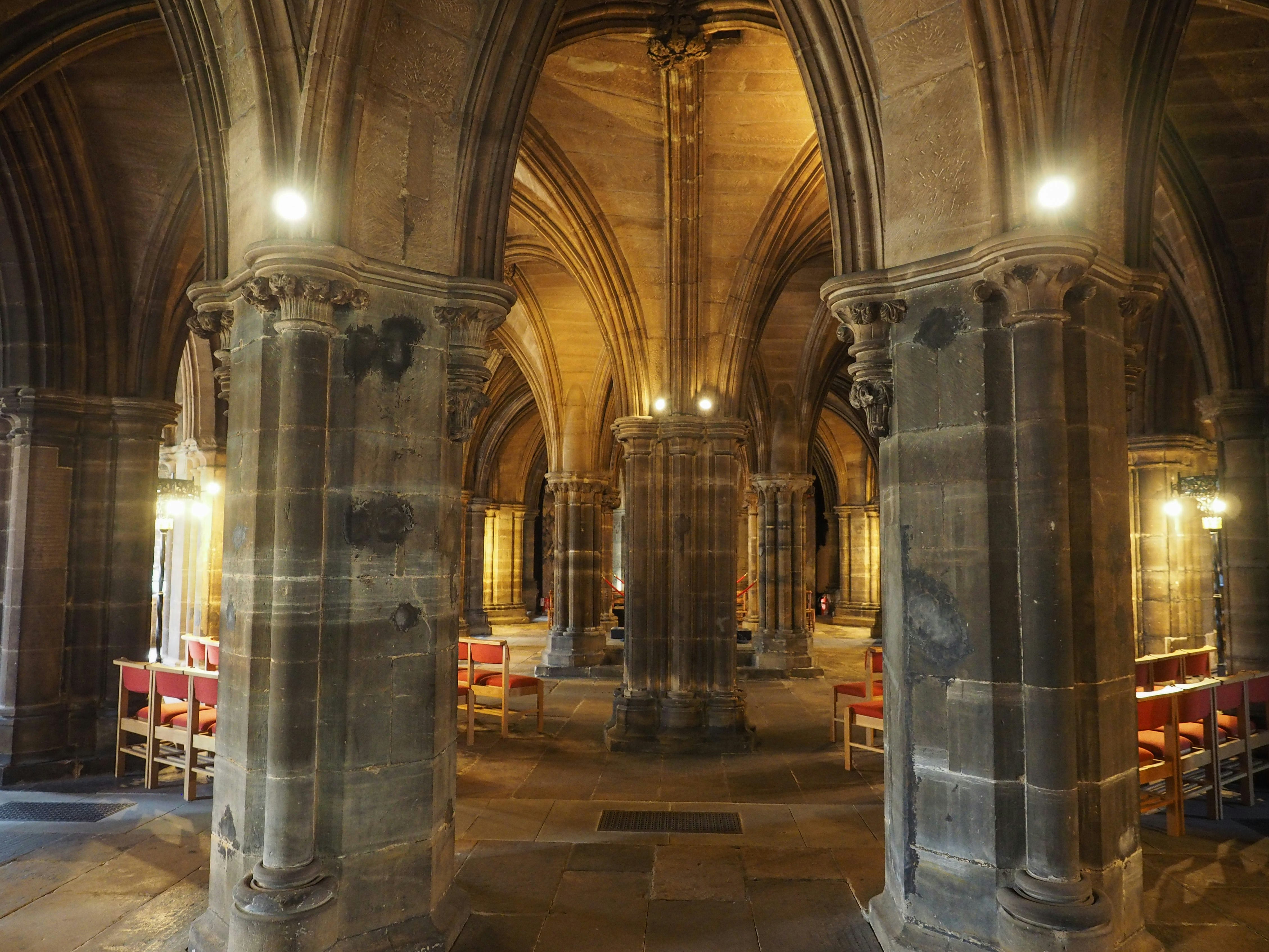
Descend into the lower church
Glasgow Cathedral was built on a sloping site, creating a lower level beneath the quire (it’s not technically a crypt, as it sits above ground level). This vaulted section of the lower church is an atmospheric space with a forest of thick columns – as you descend via the south staircase, you can see a column from the original 12th-century cathedral.
A modern altar stands over the supposed location of the tomb of St Mungo, Glasgow’s patron saint, who died in 603 CE and became a major figure for devotion in the 11th and 12th centuries, drawing droves of pilgrims to the city.
The sunken ambulatory at the eastern end has four square chapels separated by arches; this area stood in for the L’Hôpital des Anges in Paris in the 2016 TV dramatization of Outlander. The tomb of Bishop Wishart, a key supporter of Robert the Bruce and an important figure in the cathedral’s construction, is here, alongside an ancient well that predates the cathedral.
Seek out quirky details along the Blackadder Aisle
After the gloomy gravitas of the rest of the cathedral, the spectacular whitewashed vaulting of the Blackadder Aisle (also spelled Blacader – no relation to the Rowan Atkinson comedy character) feels like a ray of sunshine.
Commissioned by Robert Blackadder, Bishop of Glasgow from 1483 to 1508, the space was originally designed as the crypt for a chapel that was never constructed. Look up to the vaulted ceiling to spot a carving of a laughing skull with worms crawling out of its eye sockets.
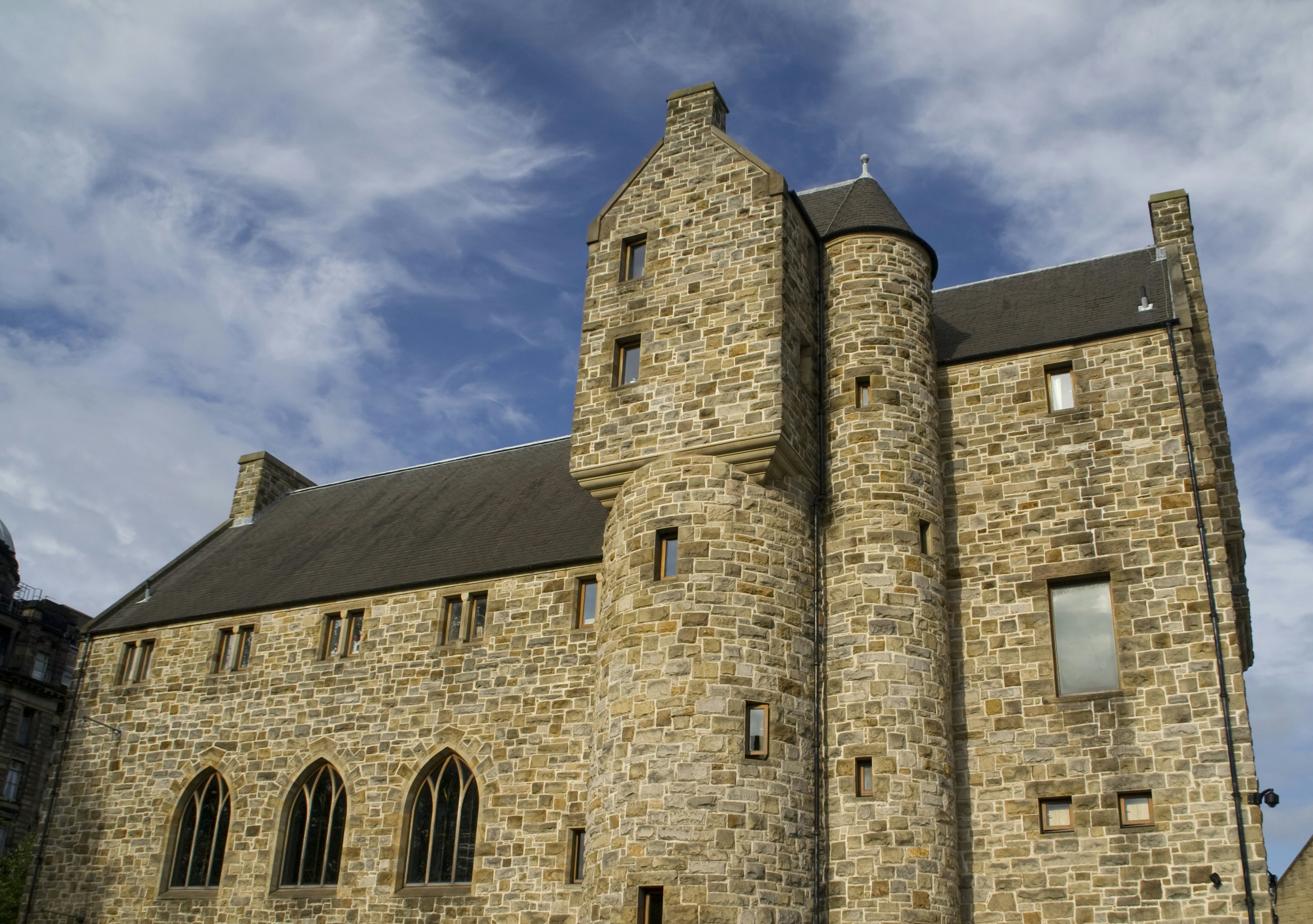
Visit the St Mungo Museum of Religious Life & Art
Just west of the cathedral, the St Mungo Museum of Religious Life & Art takes an impartial look at the six major world religions through the lens of art, from medieval times to the modern day. The result is a fascinating overview of how different faiths tackle the big questions of humanity.
Beautiful stained-glass saints and angels created by the pre-Raphaelite Edward Burne-Jones gaze over the museum’s collection of religious art, which includes a statue of the Buddha, an Indigenous-Australian Dreaming painting and Native American totems. More stained glass from the 14th and 15th centuries stands alongside powerful modern paintings by war artists Robert McNeil and Peter Howson.
The museum’s heart, the Gallery of Religious Life is a compact but immersive space that explores how different cultures and religions approach major life events through photographs and sacred objects. Explore life perspectives from Benin to British Columbia, and from the Day of the Dead to Jewish bar mitzvahs.
The top-floor exhibition covers religion in Scotland, including the Reformation, missionaries, sectarianism, multiculturalism and Scotland’s increasingly secular modern society. A striking picture window offers a view out at Glasgow Cathedral and the Necropolis, with information on the bishop’s palace that once stood here, and of which this building is a partial recreation.

View memorials to Scottish movers and shakers at the Glasgow Necropolis
From the cathedral, the Necropolis is reached via the Bridge of Sighs, constructed in 1833 to carry funeral processions over the valley of the Molendinar Burn (now culverted), where St Mungo is said to have fished for salmon in the 7th century.
Turn left and follow the zigzag path uphill past a string of ostentatious, ornate and sometimes vainglorious mausoleums and gravestones. The styles of these lavish late-Georgian and Victorian tombs touch on everything from Ancient Greek to Moorish and Baroque, and wandering between them is one of Glasgow’s great joys.
Most impressive of all is the Monteath Mausoleum from 1850, which resembles a circular Knights Templar church adorned with Hindu motifs. The deceased, Major Archibald Douglas Monteath, was an officer in the East India Company; according to local folklore, he became rich by stopping a runaway elephant and being gifted the jewels it was carrying as a reward.
Other notable tombs include the mausoleum – carved with the open curtains of a theater – of John Henry Alexander, actor and manager of Glasgow’s original Theatre Royal, and the grave of chemist and industrialist Charles Tennant, which has a life-size statue of its occupant, seated as if in deep thought.
At the summit stands an 1825 monument to the 16th-century Protestant reformer John Knox, whose body is interred in Edinburgh. From here, the views back to the cathedral and the grand Victorian frontage of the Glasgow Royal Infirmary are stunning.
At the base of the hill, look out for memorials to Scottish national hero William Wallace and Corlinda Lee, self-styled Queen of the Gypsies, who once read the fortune of Queen Victoria. To learn more about the cemetery and its residents, take a tour with the Friends of Glasgow Necropolis.
Are Glasgow Cathedral and the Glasgow Necropolis accessible?
As an ancient building, Glasgow Cathedral was not built with accessibility in mind, and visitors must climb steps to reach some areas; the West Door has a stair-lift down to the nave. The main Wishart St entrance to the Glasgow Necropolis is wheelchair accessible, and major paths are flat and paved, but there are some steps and inclines to navigate.
This article was adapted from Lonely Planet’s Scotland and Pocket Glasgow guidebooks, published in June 2025.













